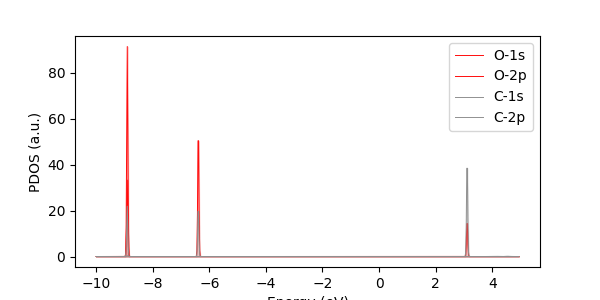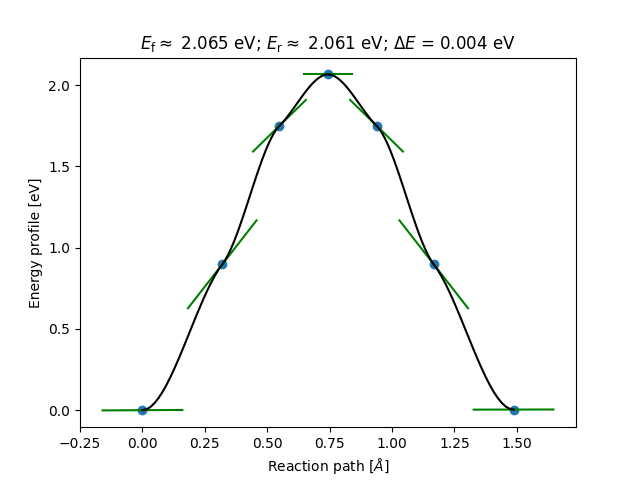Quantum ESPRESSO Calculator for Atomic Simulation Environment (ASE).
For the introduction of ASE , please visit https://wiki.fysik.dtu.dk/ase/index.html
- Support all QE packages, including: pw, band, neb, dos, projwfc, pp ...
- Spin-polarized calculation
- LD(S)A+U
- Automatic submit job
- Automatic check a new calculation required or not
- Automatic set up "nscf" calculation
- Read and plot dos, pdos and layer resolved pdos
- Plot NEB
- Xing Wang xingwang1991@gmail.com
- Python
- ASE
- numpy
- scipy
- matplotlib
pip install --upgrade --user xespresso
You can get the source using git:
git clone --depth 1 https://github.com/superstar54/xespresso.gitAdd xespresso to your PYTHONPATH. On windows, you can edit the system environment variables.
export PYTHONPATH="/path/to/xespresso":$PYTHONPATH
export ASE_ESPRESSO_COMMAND="/path/to/PACKAGE.x PARALLEL -in PREFIX.PACKAGEi > PREFIX.PACKAGEo"
export ESPRESSO_PSEUDO="/path/to/pseudo"A example of setting parameters for the queue. See example/queue.py
queue = {'nodes': 4,
'ntasks-per-node': 20,
'partition': 'all',
'time': '23:10:00'}
calc = Espresso(queue = queue)Before the calculation, it will first check the working directory. If the same geometry and parameters are used, try to check whether the results are available or not. Automatic check input parameters with Quantum Espresso document.
calc = Espresso(label = 'scf/fe')calc = Espresso(debug = True)Some atoms are special:
- atoms with different starting_magnetization
- atoms with different U values
- atoms with special basis set
For example, Fe with spin state AFM. See example/spin.py
atoms.new_array('species', np.array(atoms.get_chemical_symbols(), dtype = 'U20'))
atoms.arrays['species'][1] = 'Fe1'Hubbard, starting_magnetization, starting_charge and so on. See example/dft+u.py
input_ntyp = {
'starting_magnetization': {'Fe1': 1.0, 'Fe2': -1.0},
'Hubbard_U': {'Fe1': 3.0, 'Fe2': 3.0},
}
input_data['input_ntyp'] = input_ntyp,Hubbard, starting_magnetization, starting_charge and so on. See example/dft+u.py
input_data = {
'hubbard_v': {'(1,1,1)': 4.0, '(3,3,1)': 1.0},
}To control the number of processors in each group: -ni, -nk, -nb, -nt, -nd) are used.
calc = Espresso(pseudopotentials = pseudopotentials,
package = 'pw',
parallel = '-nk 2 -nt 4 -nd 144', # parallel parameters
}A example of nscf calculation following the above one.
# start nscf calculation
from xespresso.post.nscf import EspressoNscf
nscf = EspressoNscf(calc.directory, prefix = calc.prefix,
occupations = 'tetrahedra',
kpts = (2, 2, 2),
debug = True,
)
nscf.run()A example of calculating and plotting the pdos from the nscf calculation.
from xespresso.post.dos import EspressoDos
# dos
dos = EspressoDos(parent_directory = 'calculations/scf/co',
prefix = calc.prefix,
Emin = fe - 30, Emax = fe + 30, DeltaE = 0.01)
dos.run()
# pdos
from xespresso.post.projwfc import EspressoProjwfc
projwfc = EspressoProjwfc(parent_directory = 'calculations/scf/co',
prefix = 'co',
DeltaE = 0.01)
projwfc.run()from xespresso.post.pp import EspressoPp
pp = EspressoPp(calc.directory, prefix = calc.prefix,
plot_num = 11,
fileout = 'potential.cube',
iflag = 3,
output_format=6,
debug = True,
)
pp.get_work_function()calc.read_results()
atoms = calc.results['atoms']
calc.run(atoms = atoms, restart = 1)See example/neb.py
from xespresso.neb import NEBEspresso
calc = NEBEspresso(
package = 'neb',
images = images,
climbing_images = [5],
path_data = path_data
)
calc.calculate()
calc.read_results()
calc.plot()The workflow includes four modules:
- OER_bulk
- OER_pourbaix
- OER_surface
- OER_site
The workflow can handle:
- Generate surface slab model from bulk structure
- Determine the surface adsorption site
- Determine the surface coverage(, O, OH*), Pourbaix diagram
- Calculate the Zero-point energy
oer = OER_site(slab,
label = 'oer/Pt-001-ontop',
site_type = 'ontop',
site = -1,
height=2.0,
calculator = parameters,
molecule_energies = molecule_energies,
)
oer.run()- add
qPointsSpecsandLine-of-inputfor phonon input file

